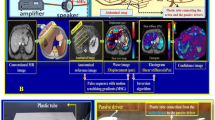Abstract
Purpose
The aim of this study was to define liver shear stiffness by magnetic resonance elastography (MRE) that distinguishes normal from abnormal liver biopsy, especially when steatosis ≥20%, among potential live liver donors.
Methods
Baseline clinical, laboratory, imaging, MRE, and liver biopsy results were recorded. Using MRE, hepatic shear stiffness in kilopascals (kPa) was measured and compared to liver biopsy. Comparison between groups was done using χ 2 or Fisher’s exact test for categorical variables and Wilcoxon test for continuous variables. Receiver operating characteristic (ROC) curve was calculated to assess diagnostic accuracy. Statistical significance was set at p < 0.05.
Results
38 healthy adults were included. Liver biopsy was normal in 27 and abnormal in 11. ROC curve for MRE defined optimal cutoff at 2.6 kPa (sensitivity 0.72, specificity 0.85, AUC 0.81) to distinguish these 2 groups. Hepatic steatosis ≥20% on biopsy is a contraindication for liver donation in our center. We evaluated the ability of MRE to distinguish this degree of steatosis: 8 persons had steatosis ≥20% and were excluded from donation. ROC curve for MRE defined optimal cutoff at 2.82 kPa (sensitivity 0.88, specificity 1, AUC 0.98) to identify this group.
Conclusions
Liver stiffness measured by MRE, even in the absence of liver fibrosis, can be useful in differentiating normal from abnormal liver histology, and most importantly in patients under evaluation for live liver donation, can very accurately distinguish those with complicated hepatic steatosis ≥20%, our cutoff for donation. In the future, MRE might provide supplementary information to make liver biopsy unnecessary in the donor evaluation process.






Similar content being viewed by others
References
Trotter JF (2014) Challenges in living donor liver transplantation. Clin Liver Dis 18(3):651–660. doi:10.1016/j.cld.2014.05.007
Trotter JF, Wisniewski KA, Terrault NA, et al. (2007) Outcomes of donor evaluation in adult-to-adult living donor liver transplantation. Hepatology 46(5):1476–1484. doi:10.1002/hep.21845
Abecassis MM, Fisher RA, Olthoff KM, et al. (2012) Complications of living donor hepatic lobectomy: a comprehensive report. Am J Transpl 12(5):1208–1217. doi:10.1111/j.1600-6143.2011.03972.x
Muzaale AD, Dagher NN, Montgomery RA, et al. (2012) Estimates of early death, acute liver failure, and long-term mortality among live liver donors. Gastroenterology 142(2):273–280. doi:10.1053/j.gastro.2011.11.015
Cheah YL, Simpson MA, Pomposelli JJ, Pomfret EA (2013) Incidence of death and potentially life-threatening near-miss events in living donor hepatic lobectomy: a world-wide survey. Liver Transpl 19(5):499–506. doi:10.1002/lt.23575
Piccinino F, Sagnelli E, Pasquale G, Giusti G (1986) Complications following percutaneous liver biopsy. A multicentre retrospective study on 68,276 biopsies. J Hepatol 2(2):165–173
Castera L, Negre I, Samii K, Buffet C (1999) Pain experienced during percutaneous liver biopsy. Hepatology 30(6):1529–1530. doi:10.1002/hep.510300624
Muthupillai R, Lomas DJ, Rossman PJ, et al. (1995) Magnetic resonance elastography by direct visualization of propagating acoustic strain waves. Science 269(5232):1854–1857
Manduca A, Oliphant TE, Dresner MA, et al. (2001) Magnetic resonance elastography: non-invasive mapping of tissue elasticity. Med Image Anal 5(4):237–254
Yin M, Talwalkar JA, Glaser KJ, et al. (2007) Assessment of hepatic fibrosis with magnetic resonance elastography. Clin Gastroenterol Hepatol 5(10):1207–1213.e1202. doi:10.1016/j.cgh.2007.06.012
Chen J, Talwalkar JA, Yin M, et al. (2011) Early detection of nonalcoholic steatohepatitis in patients with nonalcoholic fatty liver disease by using MR elastography. Radiology 259(3):749–756. doi:10.1148/radiol.11101942
Talwalkar JA, Yin M, Fidler JL, et al. (2008) Magnetic resonance imaging of hepatic fibrosis: emerging clinical applications. Hepatology 47(1):332–342. doi:10.1002/hep.21972
Venkatesh SK, Yin M, Ehman RL (2013) Magnetic resonance elastography of liver: clinical applications. J Comput Assist Tomogr 37(6):887–896. doi:10.1097/rct.0000000000000032
Bedossa P, Poynard T (1996) An algorithm for the grading of activity in chronic hepatitis C. The METAVIR Cooperative Study Group. Hepatology 24(2):289–293. doi:10.1002/hep.510240201
Brunt EM, Janney CG, Di Bisceglie AM, Neuschwander-Tetri BA, Bacon BR (1999) Nonalcoholic steatohepatitis: a proposal for grading and staging the histological lesions. Am J Gastroenterol 94(9):2467–2474. doi:10.1111/j.1572-0241.1999.01377.x
Liu A, Schisterman EF, Zhu Y (2005) On linear combinations of biomarkers to improve diagnostic accuracy. Stat Med 24(1):37–47. doi:10.1002/sim.1922
Rousselet MC, Michalak S, Dupre F, et al. (2005) Sources of variability in histological scoring of chronic viral hepatitis. Hepatology 41(2):257–264. doi:10.1002/hep.20535
Venkatesh SK, Yin M, Ehman RL (2013) Magnetic resonance elastography of liver: technique, analysis, and clinical applications. J Magn Reson Imaging 37(3):544–555. doi:10.1002/jmri.23731
Hope TA, Ohliger MA, Qayyum A (2014) MR imaging of diffuse liver disease: from technique to diagnosis. Radiol Clin North Am 52(4):709–724. doi:10.1016/j.rcl.2014.02.016
Lee DH, Lee JM, Han JK, Choi BI (2013) MR elastography of healthy liver parenchyma: normal value and reliability of the liver stiffness value measurement. J Magn Reson Imaging 38(5):1215–1223. doi:10.1002/jmri.23958
Lee Y, Lee JM, Lee JE, et al. (2014) MR elastography for noninvasive assessment of hepatic fibrosis: reproducibility of the examination and reproducibility and repeatability of the liver stiffness value measurement. J Magn Reson Imaging 39(2):326–331. doi:10.1002/jmri.24147
Venkatesh SK, Ehman RL (2014) Magnetic resonance elastography of liver. Magn Reson Imaging Clin N Am 22(3):433–446. doi:10.1016/j.mric.2014.05.001
Ma X, Holalkere NS, Kambadakone RA, et al. (2009) Imaging-based quantification of hepatic fat: methods and clinical applications. Radiographics 29(5):1253–1277. doi:10.1148/rg.295085186
Szczepaniak LS, Babcock EE, Schick F, et al. (1999) Measurement of intracellular triglyceride stores by H spectroscopy: validation in vivo. Am J Physiol 276(5 Pt 1):E977–E989
Reeder SB, Cruite I, Hamilton G, Sirlin CB (2011) Quantitative assessment of liver fat with magnetic resonance imaging and spectroscopy. J Magn Reson Imaging 34(4):729–749. doi:10.1002/jmri.22580
Pineda N, Sharma P, Xu Q, et al. (2009) Measurement of hepatic lipid: high-speed T2-corrected multiecho acquisition at 1H MR spectroscopy: a rapid and accurate technique. Radiology 252(2):568–576
Kang BK, Yu ES, Lee SS, et al. (2012) Hepatic fat quantification: a prospective comparison of magnetic resonance spectroscopy and analysis methods for chemical-shift gradient echo magnetic resonance imaging with histologic assessment as the reference standard. Invest Radiol. 47(6):368–375
Disclosures
The authors have no conflict of interest or financial involvement with this manuscript.
Author information
Authors and Affiliations
Corresponding author
Rights and permissions
About this article
Cite this article
Gallegos-Orozco, J.F., Silva, A.C., Batheja, M.J. et al. Magnetic resonance elastography can discriminate normal vs. abnormal liver biopsy in candidates for live liver donation. Abdom Imaging 40, 795–802 (2015). https://doi.org/10.1007/s00261-014-0310-y
Published:
Issue Date:
DOI: https://doi.org/10.1007/s00261-014-0310-y




